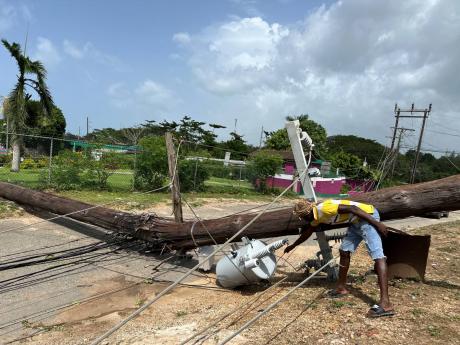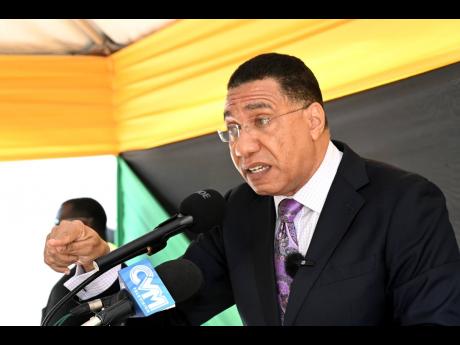Editorial | Infrastructure crisis
Prime Minister Andrew Holness struck an appropriate note with his promise on Tuesday that his government will pay attention to resilience in rebuilding from the destruction caused by Hurricane Beryl, which sideswiped Jamaica eight days ago.
This conversation, however, is not one only for Mr Holness, his minister and technocrats within the Government. For, getting resilience right, in the face of obstinacy by the developed countries in fulfilling commitments to emerging economies for climate adaptation financing, will likely require tough policy choices by the government, even as it gets small things done.
With respect to what is to be done, Mr Holness starts on a good foundation. He understands that record-breaking storms like Beryl (it formed further east of the Caribbean than any previously on record, and developed into a major hurricane faster than any) are in the future for Jamaica, given global warming and climate-change.
The important question, though, is, what are the strategies and tactics to be employed by Jamaica in accelerating its climate mitigation and adaptation efforts, as it waits for global financing initiatives to kick in?
Apart from short-term programmes to deliver relief to the people hardest-hit by last week’s storm, Mr Holness’ most specific proposal on Tuesday towards toughening the island’s infrastructure was a plan for power redundancy at the facilities of the state-owned National Water Commission. Its water filtration and plants and pumping stations are to be kitted out with backup power generators to ensure that they do not, in the future, suffer the wide-scale shutdown caused by the near collapse of the national grid during the hurricane. The absence of electricity also contributed to major breakdown in mobile telephone and Internet services provided by the island’s two private telecoms companies.
HARD-TO-ACCESS AREAS
Indeed, up to Tuesday nearly 110,000 Jamaicans, or 16 per cent of the customers of the Jamaica Public Service (JPS), the monopoly electricity transmission and distribution company, were still without power. While most of these are expected to have electricity by this weekend, it could be weeks, officials say, before some customers in the hard-hit parish of St Elizabeth, in the island’s southwest, are back on the grid.
The JPS’s main problem was that the storm, whose eyewall brushed Jamaica’s south coast, uprooted several hundred electricity poles, many of which supported trunk cables. Large portions of these were in hard-to-access areas, made more difficult by the hurricane.
Scientists say that Earth’s hotter temperatures will make storms like Beryl more frequent. In other words, electricity pylons, and the overhead transmission and distribution lines they support, will face greater, and more frequent, risks.
The potential, therefore, is for a cycle of destruction and rebuilding, unless Jamaica does something different.
It is against this background that this newspaper called for a discussion on running Jamaica’s power cables underground – an idea advanced 36 years ago by the then prime minister, Edward Seaga, after Hurricane Gilbert destroyed the electricity grid.
Except for Hope Pastures, a St Andrew suburb, whose residents are in a long-running court battle for the JPS to upgrade their subterranean system without having to finance it, electricity in Jamaica is delivered via overhead lines. Running power lines underground is expensive; in some cases, depending on the technology, it can be up to five times the cost of overhead systems.
COST-BENEFIT ANALYSIS
However, climate change adds a new dimension to that equation, considering that severe damage to overhead grids is expected to be more frequent. and expensive to repair.
In the circumstances, it is not only the cost of fixing transmission and distribution lines that has to be taken into account. The analysis must include the broader costs to an economy of more, and prolonged, power outages.
Looked at this way, the economics of underground power lines might not be as economically foreboding, especially if consumers and taxpayers help to pay for the long-term transitioning to a subterranean system.
In the past, based on the calculations by the regulator, the Office of Utilities Regulation (OUR), consumers have borne a major part of the cost of JPS’s post-hurricane repairs.
Taking into account the new scenario, the OUR should be asked to conduct a cost-benefit analysis of Jamaica’s transition, say, over 30 years, to underground cables.
However, as Beryl laid bare, it is not only in water, electricity and power that Jamaica has vulnerable infrastructure. Its roads, bridges, major drains and other facilities are in bad shape, the result of decades of underinvestment. They need upgrading.
It is clear that returns from disaster insurance premiums or investment bonds, or contingency savings, cannot deal with the scale of the problem. Nor is the economy likely to grow nearly fast enough in the near to medium term to generate the surpluses to address the issue. With the broad sweep of climate change, matters could worsen.
In the first instance, therefore, Jamaica has to do the small things and do them right, like embarking on an aggressive programme of infrastructure repair and maintenance.
At the same time, the Government has to consider how it organises its fiscal affairs to provide itself the space to address the crisis of an old and failing infrastructure.



